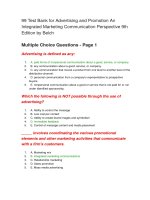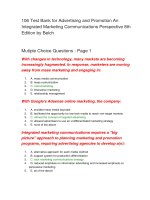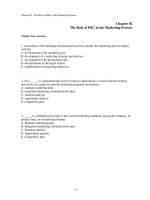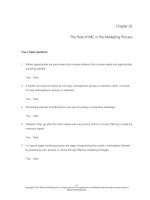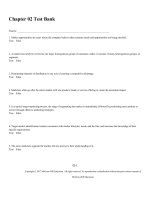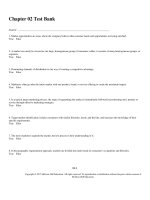Lecture Advertising and promotion: An integrated marketing communications perspective (10/e): Chapter 6 - George E. Belch, Michael A. Belch
Bạn đang xem bản rút gọn của tài liệu. Xem và tải ngay bản đầy đủ của tài liệu tại đây (688.68 KB, 18 trang )
Chapter 6
Source,
Message,
and
Channel
Factors
Copyright © 2015 McGraw-Hill Education. All rights reserved. No reproduction or distribution without the prior written consent of
McGraw-Hill Education.
Figure 6.1 The Persuasion Matrix
Copyright © 2015 McGraw-Hill Education. All rights reserved. No reproduction or distribution without the prior written consent of
McGraw-Hill Education.
2
Decisions Evaluated with the Persuasion Matrix
Receiver/
Channel/
Message/
Source/
comprehension
presentation
yielding
attention
Which media
will increase
presentation?
What type of
message will
create favorable
attitudes or
feelings?
Who will be
effective in
getting
consumers’
attention?
Can the receiver
comprehend the
ad?
Copyright © 2015 McGraw-Hill Education. All rights reserved. No reproduction or distribution without the prior written consent of
McGraw-Hill Education.
3
Source
Person involved in communicating a marketing
message
Direct source Delivers a message and/or endorses
a product or service
Indirect source Draws attention to and enhances
the appearance of an ad
Copyright © 2015 McGraw-Hill Education. All rights reserved. No reproduction or distribution without the prior written consent of
McGraw-Hill Education.
4
Figure 6.2 Source Attributes and Receiver
Processing Modes
Copyright © 2015 McGraw-Hill Education. All rights reserved. No reproduction or distribution without the prior written consent of
McGraw-Hill Education.
5
Source Credibility
Knowledge
Knowledge
Source
Source
Skill
Skill
Expertise
Expertise
Trustworthy
Trustworthy
Information
Information
Unbiased
Unbiased
Objective
Objective
Copyright © 2015 McGraw-Hill Education. All rights reserved. No reproduction or distribution without the prior written consent of
McGraw-Hill Education.
Source Attractiveness
Similarity
Similarity
Familiarity
Familiarity
Likeability
Likeability
Resemblance
Resemblance
between the
between the
source and
source and
recipient of the
recipient of the
message
message
Knowledge of the
Knowledge of the
source through
source through
repeated or
repeated or
prolonged
prolonged
exposure
exposure
Affection for the
Affection for the
source resulting
source resulting
from physical
from physical
appearance,
appearance,
behavior, or other
behavior, or other
personal traits
personal traits
Copyright © 2015 McGraw-Hill Education. All rights reserved. No reproduction or distribution without the prior written consent of
McGraw-Hill Education.
Choosing a Celebrity Endorser
Match w/audience
Match w/audience
Trust
Trust
Match w/product
Match w/product
Risk
Risk
Factors
Image
Image
Familiarity
Familiarity
Cost/ROI
Cost/ROI
Likability
Likability
Copyright © 2015 McGraw-Hill Education. All rights reserved. No reproduction or distribution without the prior written consent of
McGraw-Hill Education.
Risks of Using Celebrities
The celebrity may overshadow
The celebrity may overshadow
the product being endorsed
the product being endorsed
The celebrity may be overexposed,
The celebrity may be overexposed,
reducing his or her credibility
reducing his or her credibility
The target audience may not be
The target audience may not be
receptive to celebrity endorsers
receptive to celebrity endorsers
The celebrity’s behavior may pose
The celebrity’s behavior may pose
a risk to the company
a risk to the company
Copyright © 2015 McGraw-Hill Education. All rights reserved. No reproduction or distribution without the prior written consent of
McGraw-Hill Education.
Figure 6.3 Meaning Movement and
the Endorsement Process
Copyright © 2015 McGraw-Hill Education. All rights reserved. No reproduction or distribution without the prior written consent of
10
McGraw-Hill Education.
Source Power
Perceived control
Perceived control
Source Power
Source Power
Perceived concern
Perceived concern
Perceived scrutiny
Perceived scrutiny
Copyright © 2015 McGraw-Hill Education. All rights reserved. No reproduction or distribution without the prior written consent of
McGraw-Hill Education.
Message Factors
Message
structure
•
•
•
•
•
Message
appeals
• Comparative advertising
• Fear appeals
• Humor appeals
Order of presentation
Conclusion drawing
Message sidedness
Refutation
Verbal versus visual messages
Copyright © 2015 McGraw-Hill Education. All rights reserved. No reproduction or distribution without the prior written consent of
12
McGraw-Hill Education.
Recall
Recall and Presentation Order
Beginning
Middle
End
Copyright © 2015 McGraw-Hill Education. All rights reserved. No reproduction or distribution without the prior written consent of
McGraw-Hill Education.
Message Appeal Options
Comparative
Comparative
Ads
Ads
•• May be especially
May be especially
useful for new
useful for new
brands
brands
•• Often used for
Often used for
brands with small
brands with small
market share
market share
•• Frequently use in
Frequently use in
political
political
advertising
advertising
Fear
Fear
Appeals
Appeals
•• May stress
May stress
physical danger or
physical danger or
threats to health
threats to health
•• May identify social
May identify social
threats:
threats:
disapproval or
disapproval or
rejection
rejection
•• May backfire if the
May backfire if the
Humor
Humor
Appeals
Appeals
•• They can attract
They can attract
and hold attention
and hold attention
•• They are often the
They are often the
best remembered
best remembered
•• They put the
They put the
consumer in a
consumer in a
positive mood
positive mood
level of threat is
level of threat is
too high
too high
Copyright © 2015 McGraw-Hill Education. All rights reserved. No reproduction or distribution without the prior written consent of
McGraw-Hill Education.
Figure 6.5 Relationship between Fear
Levels and Message Acceptance
Copyright © 2015 McGraw-Hill Education. All rights reserved. No reproduction or distribution without the prior written consent of
15
McGraw-Hill Education.
Humor Appeals Advantages and
Disadvantages
Advantages
Disadvantages
• Aid with awareness and
attention
• Aid name and simple
copy registration
• Aid retention
• Aid persuasion to switch
brands
• Create a positive mood
that enhances
persuasion
• Harm recall and
comprehension
• Harm complex copy
registration
• Do not aid persuasion in
general
• Do not aid source
credibility
• Not very effective in
bringing about sales
Copyright © 2015 McGraw-Hill Education. All rights reserved. No reproduction or distribution without the prior written consent of
16
McGraw-Hill Education.
Channel Factors
Personal versus nonpersonal channels Information
received from personal channels is more persuasive
than that received from the mass media
Effects of alternative mass media
Differences in information processing
Selfpaced Readers process the ad at their own rate and
study it as long as they desire
Externally paced Transmission rate is controlled by the
medium
Copyright © 2015 McGraw-Hill Education. All rights reserved. No reproduction or distribution without the prior written consent of
17
McGraw-Hill Education.
Self versus External Paced Media
SelfPaced
SelfPaced
Media
Media
Externally Paced
Externally Paced
Media
Media
•• Newspapers
Newspapers
•• Radio
Radio
•• Magazines
Magazines
•• Television
Television
•• Direct Mail
Direct Mail
vs.
vs.
•• Internet
Internet
Copyright © 2015 McGraw-Hill Education. All rights reserved. No reproduction or distribution without the prior written consent of
McGraw-Hill Education.

